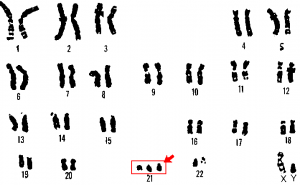
Researchers have silenced the third copy of chromosome 21, at least in a dish. What might this mean for Down syndrome? (Wikimedia Commons)
Last week, researchers at the University of Massachusetts published a fascinating and important study on Down syndrome in Nature. Lisa Hall, PhD, Jeanne Lawrence, PhD, and their colleagues were able to effectively “shut down” the gene activity of one of the three copies of the 21st chromosome in cells with trisomy 21.
What exactly did they do? The research team started with skin cells from a man with trisomy 21 that were transformed into induced pluripotent stem cells—cells that act like cells from an embryo and can develop into different cell types. They then took a gene from the X chromosome that is responsible for making sure that only one X chromosome is active in females—the X-inactivation gene—and inserted it in a specific location on chromosome 21. (Males have only one X chromosome, so there is no need for it to be inactivated.)
Insertion of this gene caused the genes on that copy of chromosome 21 to be “turned off.” Thus, even though the cells still had three copies of the chromosome, only two were active. The researchers then conducted further experiments to show that cells with one inactivated copy of chromosome 21 had improved division and growth and improved differentiation into nerve cells—similar to cells with just two copies of 21.
Why is this important? First, researchers can now compare these engineered cells with trisomy 21 cells that have three active copies of chromosome 21. This will allow experimenters to better understand the mechanisms responsible for the various medical problems seen more often in people with Down syndrome and, possibly, in other genetic disorders that involve duplication of a chromosome.
Also, down the road, this research methodology could perhaps be used to treat Down syndrome by shutting down the extra chromosome 21.
Does this pose an ethical dilemma? For people with Down syndrome and their families and friends, this idea raises many questions. What would it mean to “treat” the genetic condition that is so intricately related to what makes someone himself or herself? If you could prevent the heart defects, sleep apnea, hearing loss and cognitive challenges, which of the unique and positive traits common in people with Down syndrome might you also unintentionally alter—the joyful smiles, the tender compassion?
I am grateful that we live during times when genetic discoveries like this can help us get closer to understanding how to help people with Down syndrome and other genetic differences to lead healthy lives. At the same time, I hope our society continues to value and celebrate all people. In the Boston Children’s Hospital Down Syndrome Program, we continue to expand our involvement in exciting clinical research. As we have since 1967, we will continue to provide support, information, and world-class medical care to children with Down syndrome and their families.







